C. SÎRBU, Ad. OPREA Taking into consideration the above aspect, it is possible that many chorological data referring to <strong>Reynoutria</strong> japonica (=Polygonum cuspidatum) from Romania must be reconsidered <strong>and</strong> assigned to <strong>Reynoutria</strong> x bohemica. As a result, we consider that the real spreading of this plant in Romania is not completely known yet, further investigations for establishing its real invasive area being necessary. Description. <strong>Reynoutria</strong> x bohemica is distinct from <strong>Reynoutria</strong> japonica (with which it was confused in Romania, in the past) by a bigger habitus (- 4 m high), bigger leaves (up to 23 cm long <strong>and</strong> 19 cm wide) with slightly cordate or truncated base, <strong>and</strong> 2-3-cellular, acute hairs on the veins from the underside of leaf (Figure 1). <strong>Reynoutria</strong> japonica has not hairs on its leaves, but heavily ornamented single cells (Bailey et al., 1996); panicle is commonly shorter than the subtending leaf length (Barney et al., 2006). Fig. 1 - <strong>Reynoutria</strong> x bohemica: hairs on the underside of leaf Historical considerations <strong>and</strong> general spreading. In 1983, <strong>Chrtek</strong> & <strong>Chrtková</strong> described <strong>Reynoutria</strong> x bohemica from the Central Bohemia (Czech Republic), as a new species in science. Nevertheless, its presence in Europe dated since the second half of the 19 th century. In 1872, it was cultivated in English gardens (under one of its parents’ names), the oldest herbarium records originating from the Manchester Botanic Garden (Bailey & Conolly, 2000 quoted by M<strong>and</strong>ák et al., 2004). In the Czech Republic, there were data about the presence of this species (cultivated as ornamental) since 1942 (Pyšek et al., 2002), but at present, in this country, <strong>Reynoutria</strong> x bohemica is reported as a wild plant in over 381 localities (M<strong>and</strong>ák et al., 2004). 44
TWO ALIEN SPECIES IN THE SPREADING PROCESS IN ROMANIA Nowadays, it is cited in the majority of the central <strong>and</strong> western European countries: Great Britain <strong>and</strong> Irel<strong>and</strong> (Webb, 1993; Bailey et al., 1996), Czech Republic (<strong>Chrtek</strong> & <strong>Chrtková</strong>, 1983; M<strong>and</strong>ák et al., 2004), Slovakia (Eliaš et al., 2001; Eliáš ,2004), Pol<strong>and</strong> (Fojcik & Tokarska-Guzik, 2000), France (Kerguélen, 1993; Brunel & Tison, 2005; Schnitzler & Bailey, 2005), Switzerl<strong>and</strong> (Gerber, 2006; Shaw & Schaffner, 2006), Belgium (Tiébré & Mahy, 2005), Germany (Kowarik & Schepker, 1998), Hungary (Balogh, 1988, cited by Balogh & Bailey, 2003; Balogh, 2003), as well as in Bulgaria (Vladimirov, 2005) <strong>and</strong> Ukraine (Tisa Basin) (Drescher et al., 2003). It is also known in North America (Zika & Jacobson, 2003; Barney et al. 2006, FNA) <strong>and</strong> Japan (Bailey, 2003, cited by M<strong>and</strong>ák et al., 2004). The immigration way in Romania. Regarding the way of this species immigration in Romania, there are two hypotheses: either it was directly imported from Central Europe (under the name of <strong>Reynoutria</strong> japonica or Polygonum cuspidatum), to be cultivated as ornamental, <strong>and</strong> then it escaped from gardens, or it spread on natural ways from west to east, along watercourses (Tisa, Someş, Mureş, etc.), first in Transylvania, then in Moldavia, along the intra-mountain corridors. Biology <strong>and</strong> ecology. <strong>Reynoutria</strong> x bohemica is a geophyte (with rhizome), generally hexaploid (2n=66) (but tetraploid <strong>and</strong> octoploid clones may also be found) (Bailey et al., 1996; M<strong>and</strong>ák et al., 2003), mezophyllousmezohigrophyllous; it flowers during July-October. The flowers are hermaphrodite or female; the hermaphrodite ones are generally self-incompatible, that is they are unable to form seed without an additional source of pollen (Bailey et al., 1996; Balogh & Bailey, 2003). The main mode of reproduction is the vegetative one (with rhizomes, less aerial stems) (Bímová et al., 2003; Pyšek et al., 2003; Balogh & Bailey, 2003; M<strong>and</strong>ak et al., 2004), but the regeneration rate <strong>and</strong> final shoot mass are significantly affected by genotype (Pyšek et al., 2003). It invades riparian habitats, especially riversides <strong>and</strong> various anthropic disturbed habitats (roadsides, railways, waste places, uncultivated fields, etc.); it often spreads the natural or semi-natural vegetation (M<strong>and</strong>ák et al., 2003; Zika & Jacobson, 2003; Balogh & Bailey, 2003; Gerber, 2006; Kovács, 2004; Kovács, 2006; Fenesi, 2004; Oprea & Sîrbu, 2006). It is more frequent in hilly (Balogh & Bailey, 2003) or mountainous regions. From the phytocoenological point of view, the populations of this species enter the structure of some vegetal communities of Galio-Urticecea class, Convolvuletalia sepium order, Senecion fluviatilis alliance (Kovács, 2004; Kovács, 2006; Fenesi, 2004; Oprea & Sîrbu, 2006). The invasive character. Together with its parental species, native from East Asia, <strong>Reynoutria</strong> x bohemica is one of the most important invasive species in Europe (Balogh & Bailey, 2003, M<strong>and</strong>ák et al., 2003) <strong>and</strong> North America (Zika & 45



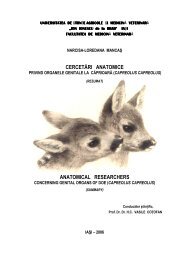
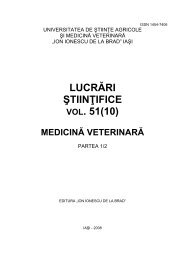

![rezumat teză [RO]](https://img.yumpu.com/19764796/1/190x245/rezumat-teza-ro.jpg?quality=85)




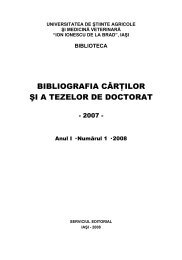
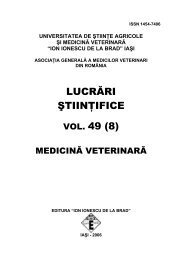
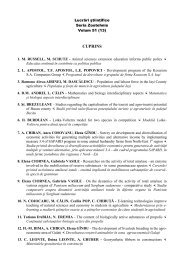

![rezumat teză [RO] - Ion Ionescu de la Brad](https://img.yumpu.com/14613555/1/184x260/rezumat-teza-ro-ion-ionescu-de-la-brad.jpg?quality=85)
